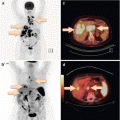© Springer International Publishing Switzerland 2016
Alwin Krämer and Harald Löffler (eds.)Cancer of Unknown Primary10.1007/978-3-319-22581-4_1212. Future Directions
(1)
Clinical Cooperation Unit Molecular Hematology/Oncology, German Cancer Research Center (DKFZ) and University of Heidelberg, Heidelberg, Germany
Keywords
Carcinoma of unknown primaryCUPGene expression profilingNext-generation sequencingTargeted therapiesPersonalized medicinePrecision oncology12.1 Personalized Medicine and Precision Oncology
When thinking about possible future directions in the management of CUP, it seems worth to pay attention to the fact that the whole field of oncology (and even medicine in general) might face a paradigm shift in the near future. Terms that are being used in this context include “personalized cancer medicine” and “precision oncology,” which are commonly defined as individualized treatment based on the molecular characteristics of a tumor from an individual patient [1–3]. What is the difference to current practice in clinical oncology? The central dogma of evidence-based medicine has taught us that any hypothesis regarding the effect of a medical intervention needs to be confirmed, if possible, in a prospectively randomized controlled trial. This implies that sufficiently large groups of patients are treated with standardized therapy protocols, thereby limiting individualization of treatment. With the advent of molecularly targeted drugs, this is predicted to become more and more problematic since patient groups benefiting from a given agent, or a given combination, become smaller and smaller. In addition, every targeted drug ideally needs to be connected to a molecular predictor, which must be validated. Currently, it is far from clear how this dilemma should be handled in the context of evidence-based medicine. Up to now, the impact of targeted therapies is therefore limited due to their, in many cases, broad-spectrum application in the absence of validated molecular predictors.
12.2 From Nonspecific Standards to Individualized Approaches?
Management of CUP is currently dictated by two approaches: Patients could either be treated according to uniform standards generally applicable to this entity, or individualized approaches could be applied. One such individualized approach is to tailor therapy according to the most likely site of origin, as traditionally incorporated into CUP management by the definition of “prognostically favorable” subgroups. Gene expression profiling has extended the possibilities to define a likely site of origin, raising the percentage of CUP cases where a reasonable working hypothesis can be defined from 10–30 % to 80 % or more. One obviously possible future direction may therefore be that uniform CUP therapy standards will gradually disappear, and instead, a likely site of origin will be defined in most cases, leading to assignment of site-specific therapies. However, as already discussed, there is still no high-level evidence that molecular site-of-origin assignment yields any therapeutic benefit in comparison to conventional standard treatments. Hence, it may still make sense to advance therapeutic standards applicable to CUP independently of site-of-origin assignment. Such therapeutic advances may include molecularly targeted therapies, which may become established for unselected patients as long as there are no suitable molecular predictors and exemplified by the use of bevacizumab/erlotinib in phase II trials [4, 5]. Another promising field of innovation is the recently established cancer immunotherapies, with antibodies to cytotoxic T-lymphocyte-associated antigen-4 (CTLA-4) and programmed death-1 (PD-1) or programmed death ligand-1 (PDL-1), whose mechanisms of action are fundamentally different from “traditional” targeted therapies since they do not target tumor cells but act on tumor-responsive immune cells instead [6–10]. Some of these novel antibodies have already been approved for the therapy of advanced malignant melanoma and are being tested in a wide range of other malignancies. They may be promising for CUP as well, although it should be noted that for these substances, validated molecular predictors are missing so far as well.
Apart from site-of-origin assignment, there might be another individualized approach to the management of CUP patients: Patients could be stratified according to molecular targets warranting targeted therapies, which may be efficient independently from the site of origin. For example, trastuzumab has been approved for both breast and gastric cancers, the relevant predictor for its efficacy being in both entities HER-2/neu overexpression [2, 11]. Since the field of oncology will likely see a growing number of molecular targets for which both suitable drugs and validated tests to predict their efficacy are available, it may be possible to transfer these relations from larger entities to CUP. Indeed, there is a, probably growing, trend that molecularly targeted drugs are tested in so-called basket studies where the eligibility for treatment with the respective drug solely depends on the molecular target, while the organ site is irrelevant [12]. With regard to CUP, this means that determining the site of origin might gradually become less relevant, although it has to be mentioned that there are examples where the predictive value of a therapeutic target depends on the organ site, e.g., BRAF inhibition, which has been proven beneficial in malignant melanomas while there seems to be no benefit in colorectal cancer [13–16].
Stay updated, free articles. Join our Telegram channel

Full access? Get Clinical Tree







